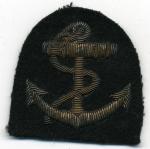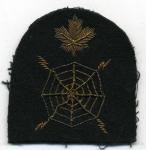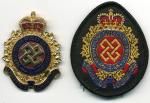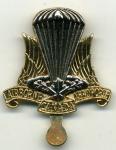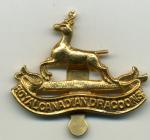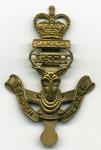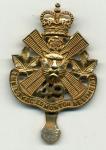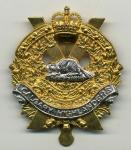-
Posts
4,302 -
Joined
-
Last visited
-
Days Won
4
Content Type
Profiles
Forums
Blogs
Gallery
Events
Store
Everything posted by Laurence Strong
-

What do we have here
Laurence Strong replied to Laurence Strong's topic in State, Civil Awards & Decorations
Thanks guys. might have to watch this one -

What do we have here
Laurence Strong replied to Laurence Strong's topic in State, Civil Awards & Decorations
-

What do we have here
Laurence Strong replied to Laurence Strong's topic in State, Civil Awards & Decorations
The reverse, I have seen them in the fashion of the bottom 1, but not like the upper set, is that a proper way of doing the backs? -
I found this surfing ebay, I have Id'd some of the ribbons Top bar: ?/ Hindenburg /? Bottom bar Ungarische.../ Hindenburg /Oesterreich... Are they upside down? Should the Hindenburg be in the middle? Is this a pair of made up bars? Thanks for your help
-
My Last combat arms hat badge belongs to the now disbanded "Canadian Airborne Regt" Formed on Canada Day in 1942 as the 1st Canadian Parachute Bn, served in WW2 as part of 6th Airborne Div as a unit of the 3rd Para Bde. It was disbanded after WW2, reformed in 1968 ad the "CAR". The battalion was perpetuated in the infantry commandos of The Canadian Airborne Regiment, whose colours carried the battle honours: Normandy Landing, Dives Crossing, The Rhine, and North-west Europe 1944 - 1945. It was once again disbanded in an attempt by the PC mandarins in Ottawa, as a means of "getting rid of the fleas by shooting the horse", There was an incident in Somalia, and numerous releases of "hazing" videos that resulted in the end happening.
-
Lord Strathcona's Horse (Royal Canadians) The regiment was one of the last in the British Empire to be created and raised by a private individual. During the Boer War, Donald Alexander Smith, 1st Baron Strathcona and Mount Royal, recruited and equipped the cavalry regiment at his own expense for service in South Africa. Many skilled horsemen (cowboys and North West Mounted Police members) enlisted, allowing for a short training period and rapid deployment to Africa. The 537 officers and men, as well as 599 horses, of the new regiment sailed from Halifax on 18 March 1900 and arrived in Cape Town on 10 April. On 5 July 1900 at Wolwespruit, Standerton, South Africa, a party of Lord Strathcona's Horse (38 in number) came into contact and was engaged at close quarters with a force of 80 of the enemy. When the order was given to retire Sergeant Richardson rode back under very heavy cross-fire, picked up a trooper whose horse had been shot and who was badly wounded and rode with him out of fire. This act of gallantry was performed within 300 yards of the enemy and Sergeant Richardson was himself riding a wounded horse. He earned the Regiments 1st of 3 VC's After the war, the regiment boarded ship at Cape Town on 20 January 1901 and arrived in London on 14 February. Here they met Lord Strathcona for the first time and were presented their medals by King Edward VII personally. On its return to Canada on 9 March 1901, the Regiment was disbanded. The regiment was recreated as regiment of the Permanent Force in 1909. In the First World War, the regiment served dismounted during the long static portion of the war, but when the front lines began to move back and forth in 1918, it fought as cavalry again and was one of key units involved in halting Germany's Operation Michael in late March. Volunteers from the regiment form the Mounted Troop, a ceremonial cavalry troop equipped with scarlet tunics, brass helmets, lances, and sabres. The regiment has the honour of being the only unit other than the Household Cavalry, the King's Troop, Royal Horse Artillery and the Royal Canadian Mounted Police to mount the Queen's Life Guard at Horse Guards in London The first badge is an older brass on, and the second is current issue
-
Next The "Royal Canadian Dragoons". It is the most Senior Cavalry regiment in Canada formed in 1883 as the "Cavalry School Corps"., in1887 renamed the "Royal School of Cavalry", before becoming the "RCD's" in 1893. Battle Honours: North West Canada 1885, South Africa 1900 The Great War: Festubert 1915, Somme 1916 '18, Bazentin, Pozi?res, Flers-Courcelette, Cambrai 1917 '18, St. Quentin, Amiens, Hindenburg Line, St. Quentin Canal, Beaurevoir, Pursuit to Mons, France and Flanders 1915-18 The Second World War: Liri Valley, Gothic Line, Lamone Crossing, Misano Ridge, Sant' Angelo-in-Salute, Fosso Vecchio, Italy 1944-45, Groningen, Bad Zwischenahn, North-West Europe 1945
-
The Saskatchewan Dragoons Reserve unit out of the province of Saskatchewan in the Cities of Moose Jaw and Saskatoon, formed as the 95th Regt of Canadian Militia in 1905, Served in WW1 as the 46th Bn, served in WW2 as the "Kings Own Rifle's of Canada" redesignated in 1946 as the "20th (Saskatchewan) Armoured Regiment, attaining it's current designation as the "Saskatchewan Dragoons (20th Armoured Regt) in 1954. That is the crest of the Province of Sask on the badge. Sergeant Hugh Cairns, who had come to the 46th Battalion from the 65th Battalion, was awarded the Victoria Cross posthumously for his actions at Valenciennes on 1 November 1918. He was the last Canadian to win the Victoria Cross in World War I. The armoury in Saskatoon is named in his memory, as is a street in Valenciennes - the only street in France named after a non-commissioned soldier of a foreign army.
-
Next the "South Alberta Light Horse". Started life as the Rocky Mountain Rangers in 1885, in 1905 became the 15th Light Horse. Served in WW1 as the 31st Bn. Became the "South Alberta Regiment" in 1920. Fought thru WW2 as the29th Canadian Armoured Recce Regt, before becoming SALH in 1949, Commonly known as "Sally Horse"
-
The "Loyal Edmonton Regiment" a reserve unit in Edmtn, this hat badge is worn with a piece of red cloth behind it, recieved after Ortona I think. Started out as the 49Bn in WWl, fought in Paaschendale, the Somme and Vimy Ridge in the 1st War, Gain it's most fame during the Battle of Ortona. Was decreed the "LER" by Royal Charter around July 1943 by King George lV. Also known as 4Bn PPCLI. The Battle of Ortona On 5 December the Loyal Edmontons, with other units of 1st Division, pushed across the Moro River to break the line that Hitler had ordered held at all costs. This was the beginning of the bloodiest month in the history of the 1st Canadian Division, and by the end of the month more than 5,000 replacements had gone forward to units from the replacement depots. The Loyal Edmontons had suffered nearly 500 casualties, of whom 92 were killed. Battling against Hitler's crack 1st Paratroop Division, the Loyal Edmontons helped take Vino Ridge on the approach to Ortona after nine days of fighting under the worst possible conditions. Sleet and rain had turned the entire countryside into one great mudhole. Tanks became stuck. But in spite of the fanatical resistance put up by the enemy, the Canadians pushed on to take the ridge two days later, on 20 December, 1943, and the first elements of D Company, under the command of Major (later Lt. Col.) J.R. Stone, DSO, MC, and Lt. (later Maj.) J.A. Dougan, MC and bar, pushed into the outskirts of Ortona. Room by room, house by house, street by street, the bloody battle in Ortona continued for eight days. Finally Maj. W.G. Longhurst, commanding A Company, devised the scheme of using beehive explosive charges to blow through the walls of the houses, and advancing rapidly on the day of 27th almost completely cut the Germans off. On the morning of the 28th, the Loyal Edmonton Regiment were in command of the wrecked town. For destroying the crew of an anti-tank gun that was holding up the advance in the town, Maj. Stone was awarded the Military Cross. For his direction of the fighting, Lt. Col. Jefferson was awarded the bar to his DSO and a few days later was promoted to Brigadier and left the unit for England. Before and after this time, well-deserved fighting soldiers' decorations -- Medals of Merit, Distinguished Conduct Medals, Military Crosses and DSOs -- came steadily to privates, non-commissioned officers, warrant officers and officers of the regiment. More important than the decorations was a fact that by now was solidly established: the skill, courage and never-failing cheerfulness with which the private soldiers of the regiment fought on. The unit established a reputation for dependability and was able to boast -- as had the 49th of the First World War -- that the Germans never forced the battalion to withdraw
-
A little trivia about the "Cal Highs" "From the east end, the Black Watch had the job of leading off. They were driven to ground and had to dive into the mud on either side of the dyke. Then it was the Calgary's turn, still night, Germans still firing everything they had. The Calgarys moved up, perhaps three to four hundred metres, losing men every step of the way, but advancing towards the objective which was Walcheren Island. By five, say six o'clock in the morning, after a crazy, confused night, the Canadians finally had their toehold on Walcheren Island. To get there, they had to come up a narrow strip of land about one kilometre in length. Today it?s a major highway. On the last day of October in 1944, it was another kind of road, a road that was littered with dead bodies. But a road also that has written a page of valour into the history of Canada. To move north from Antwerp about 10 kilometres and to turn east and capture the whole north of the Scheldt, we were looking at probably three days. But because of the decision to stop at Antwerp, it took nearly two months of some of the most intensive fighting in any land battle in World War II for the Canadians to get this far, to get to where they had a toehold across the Causeway on Walcheren, at a cost roughly estimated at 1,500 Canadian dead. The tragedy of it all, is that nobody would listen to the Dutch Resistance. The Dutch Resistance had told the Canadians and the higher command right from the start; you don't have to go across that Causeway. They said, ?Look, you can forge across the Sloe.? And that?s, of course, exactly what the British did four days later." Officers Hatbadge
-
Sorry Keith I don't have a whole lot of WWl items, most of mine are more modern, and were aquired for the most part over 16+ years in the CF That does it for badges with a personal connection to me. The next one's are from the Calgary Highlanders, a Reserve unit from Calgary of all places. First the NCM badge






